OAH Agency Rule Template
The OAH Agency Rule template is a tool that Rulemaking Coordinators can use to format rules prior to submission to OAH. The template contains formatting styles and various utilities to assist Rulemaking Coordinators with creating rules that adhere to the requirements set out in 26 NCAC 02C .0108.
The Template was developed using Microsoft Word 2016 and should function properly in Microsoft Word 2010 or higher.
This page gives an overview of the key functions of the template available for formatting a rule. The complete documentation for the template is available to download and print. Complete Template Documentation
If you have any questions about the template contact Julie Eddins at 984-236-1937.
Downloading the OAH Agency Rules Template
The template can be downloaded from the Information for Rulemaking Coordinators page. Once on the page scroll down until the Agency Rule Template block is visible.
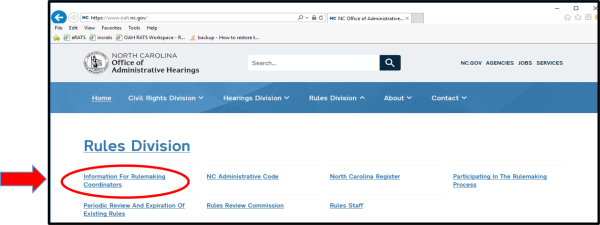

Right Click on the "Rule Template" Link and select "Save Target As" (Internet Explorer) or "Save Link As" (Chrome).
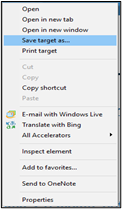
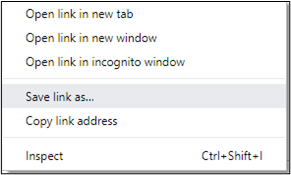
Save the template to your desktop. Do not change the name of the template. The template will not function properly if the name is changed.
Once the template is saved, open the template by right clicking on the template icon and selecting open. You will be prompted to Enable the Template. Close the template after it has been enabled. This is only done the first time the template is opened.
Note: It is also possible to store the OAH Agency Rules Template in either the default Word User or Workgroup template locations. This subject is not covered in this documentation but additional information about template locations is discussed in this blog posting which is applicable for Microsoft Word 2010 and higher: http://www.addbalance.com/word/workgrouptemplates.htm. The instructions in this document assume that the template is stored on the user’s desktop.
Using the Template
To use the template, double click on the Template Icon on the Desktop. A new document based on the template will be created. An OAH tab will be added to the Microsoft Word Ribbon. The document will automatically be in 1.5 line spacing and contain line numbers as required in 26 NCAC 02C .0108.

The Insert Rule option provides two options for inserting rules into a document. The Insert Rule from Code option retrieves the rule from the OAH website and inserts it into the document. Insert Rule from File will insert a file stored on a computer or network.
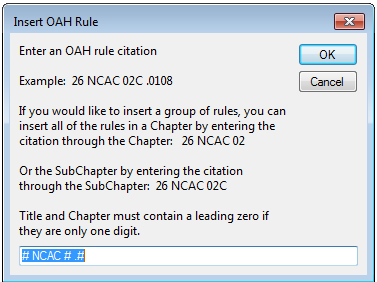
The Insert Rule from Code window allows you to insert an individual rule, all rules contained in a Subchapter, or all rules contained in a Chapter.
To insert a specific rule, enter the Title, Chapter, Subchapter (if applicable), and rule number then click OK.
To insert a Chapter, enter the Title and Chapter numbers then click OK.
To insert a Subchapter, enter the Title and Subchapter numbers the click OK.
The Title and Chapter/Subchapter numbers that are only a single digit, must be preceded by a zero.
Note: The Insert Rule function inserts the text currently published in the NC Administrative Code. If a different version of the rule is in publication, pending Rules Review Commission action or pending Legislative Review, the text of that version of the rule will not be inserted.
To ensure consistency in the format of rules, the template contains the specific styles used by the Office of Administrative Hearings. There are three ways to format a rule: subdivided from the beginning, introductory paragraph with a listing, and a single paragraph.
The following tables provide formatting details for each rule style and the history note.
Subdivided from the Beginning
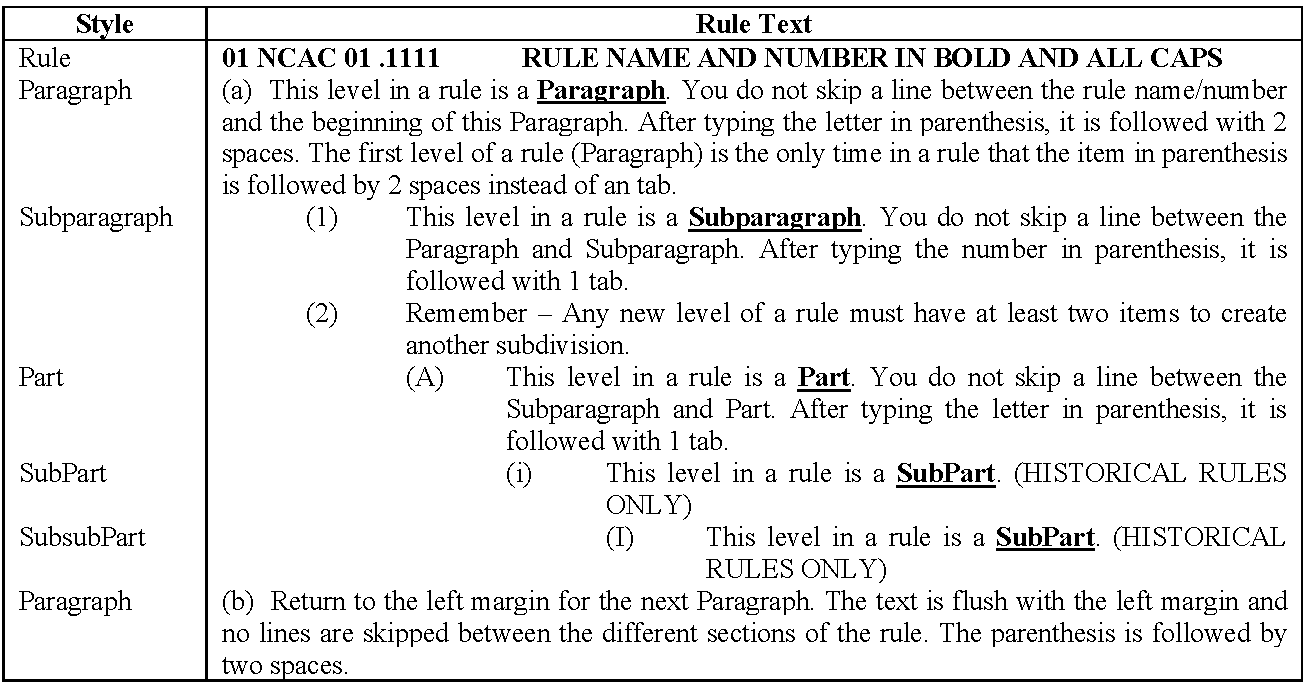
Introductory Paragraph with a Listing

Single Paragraph

History Notes


The OAH Rule Formatting dropdown menu displays the OAH formatting options. The menu is divided to categorize each option. The Style names and descriptions are displayed.

- The first three sections contain the three options for formatting rules.
- The fourth section displays the standard language options for History Notes.
- The fifth section displays less frequently used styles.
Applying a style
Select the text then click the style you want to apply.
No text or punctuation will be added. You will need to manually add spaces or tabs that are applicable to the selected style.
Select Style dropdown

This dropdown menu displays all formatting styles used by OAH and is a second method to apply styles to text.
To apply a style using this method, select the text to be formatted and click the appropriate style.
No text or punctuation will be added; this menu only applies formatting to the selected text. You will need to manually add spaces or tabs that are applicable to the selected style.
If you need to reset the format of a paragraph or the entire rule and start over, the Clear Formatting Button removes all formatting styles from the selected text.

The Auto Format Group is another way to format text.
To use this option OAH styles must first be applied to the text.
The right and left arrow buttons change the style of the text at the location of the curser to the next or previous style.

The Text Group menu provides options to insert introductory statements into a rule.
Proposed Intros and Permanent Intros drop down menus
The Proposed Intros and the Permanent Intros dropdown menus display options for introductory statements.
Selecting a menu item from the dropdown list inserts the introductory statement at the location of the cursor in the document. If the cursor is located by the rule citation, the rule citation will be inserted with the introductory statement. A blank line is inserted after the introductory statement.
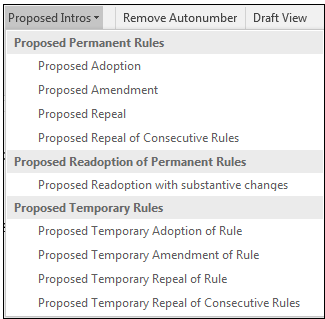
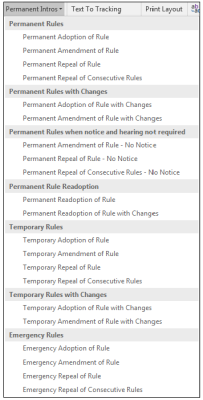
OAH rulemaking guidelines do not allow agencies to submit rules that contain auto numbered enumerated lists or Tracking (Microsoft Word revision marks). OAH recognizes that these features can be beneficial during the rule drafting process, however, they should be removed prior to submitting rules to OAH.

Remove AutoNumber Button
The Microsoft Word auto number feature automatically alters the indention level and the wrapping structure of text.
When a document is created or opened in the OAH Agency Rules Template, the auto number feature in Word is disabled.
Rules already in the rulemaking process prior to the introduction of the OAH Agency Rules Template may contain auto numbered lists. The Remove AutoNumber feature converts auto numbered lists to standard enumerated text. When this option is selected, the text can not be reverted back to an auto number format.
Tracking To Text Button
The use of "tracking" may create complications when OAH processes rules for publication in the NC Register and Administrative Code. For this reason, rules should not be submitted to OAH with “tracking”.
The Tracking to Text feature converts “tracking” to underlining and strikethrough font attributes in the document. Once “tracking” has been converted to text the editorial information regarding when changes were made and by whom will be lost from the document.
NOTE: There can be a great deal of complexity in documents containing “tracking”, therefore, it is recommended that after running this utility the agency staff carefully review the document to ensure that the revisions are accurately represented.
Text to Tracking Button
The rules and notices processed by OAH will show revision marks as underlining and strikethrough. The Text to Tracking Button converts the underlining and strikethrough in a document back into tracking (Microsoft Word revision marks). The revision data associated with the changes will be that of the user at the time the Text to Tracking Button is pressed.
The Split Rule button is located in the miscellaneous group on the OAH toolbar. It is often helpful to work on multiple rules in one document, but OAH requires that rules be filed as individual rule documents.
The split rule function creates individual documents for each rule included in a combined document. The utility uses the history note or authority line to determine where a rule ends. It uses the rule citation to name the individual rule document. Rule range documents will be created if there are multiple rule citations with only one history note (as is often the case for repealed rules). The original document must be saved before you click the Split Rule button, and the document must contain more than one rule. The original document is not modified.
The split rule function is a great tool to use when preparing proposed rules for submission to the RRC. When rules are processed for publication in the Register the correct styles are applied to each level of text and the rules may be revised to conform to formatting requirements set out in 26 NCAC 02C.
To split rules from a Notice of Text:
- Open the template;
- Insert the Notice into the template;
- Delete all of the notice information that precedes the rules;
- Save the notice;
- Click the split rule button; and
- Follow the prompts to complete the process.
